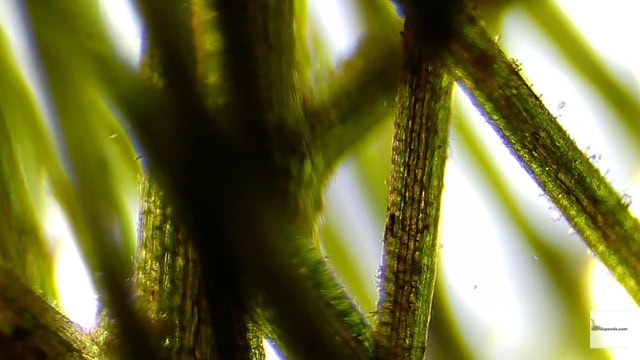When it comes to building ponds, I always follow an ecosystem approach, inspired by “The Pond Guy.” Working with Mother Nature, not against her, is key to creating a thriving, sustainable pond environment.
In this post, I’ll share how I integrate DIY filters, rocks, pebbles, and plants to enhance the natural balance in my ponds. If you prefer video format you can watch my youtube video (link below).
I was lucky enough to be sent a OPQPQ microscope (Amazon link) for free, it gave me the chance to see up close some of the microfauna that calls a pond home.
The Ecosystem Approach to Pond Building
Creating a balanced ecosystem in your pond is essential for maintaining clear, healthy water.
I use DIY pond filters that host beneficial bacteria and micro-organisms, which are crucial for breaking down waste products and purifying the water. These natural processes help keep the pond water clean without relying on harsh chemicals or excessive maintenance.
In addition to filters, I incorporate rocks, pebbles, and aquatic plants in my ponds. These elements provide extra surface area for bacteria and biofilm to grow, creating a healthy environment for microorganisms.
The plants not only add beauty but also contribute to the pond’s ecosystem by offering shelter and oxygen for fish and other aquatic life.
Understanding Pond Sediments: The Role of Beneficial Microorganisms
Over time, sediments, detritus, and organic material naturally accumulate in a pond. While some might see this as a nuisance, it’s actually a vital part of the pond’s ecosystem.
These layers of muck are teeming with life—bacteria, algae, diatoms, phytoplankton, invertebrates, snails, worms, and other small creatures all contribute to breaking down waste and forming a natural food chain.
Most of these organisms are invisible to the naked eye, but they play a crucial role in maintaining the pond’s health. To better understand what’s happening on a microscopic level, I recently received a microscope from a company I’ll call OPQPQ.
They asked me to explore my ponds with it, and I was excited to dive into this new perspective.
Using a Microscope to Explore Pond Life
The microscope I received came in a convenient carry case, complete with a charging cable, a few slides (though some were damaged in transit), and an easy-to-follow manual.
What I appreciated most was the microscope’s large screen, which made it easy to see the tiny organisms in my pond.

Additionally, I could connect the microscope to my smartphone or computer, making it simple to capture photos and videos of what I found.
As someone new to microscopy, I was fascinated by what I saw. Here’s a closer look at some of the samples I explored:
Analyzing Pond Muck: A Hidden World of Microorganisms
I started by collecting muck from my courtyard pond. Even without a deep understanding of microscopy, I was amazed by the diversity of life within this organic material.
Tiny organisms swam around, some moving quickly, others more slowly. At one point, I saw something resembling a microscopic Pac-Man dart across the screen—a thrilling discovery!

Investigating String Algae: Structure and Function
Next, I took a closer look at string algae. Although I didn’t observe much activity within the algae itself, seeing its structure up close was intriguing.
There was an almost invisible energy or pulse around certain strands, which didn’t capture as well on my phone as it did on the microscope’s screen.
String algae is often a problem in new ponds, but I’ve noticed it tends to disappear as the pond matures.
The lack of diversity in the algae sample compared to the muck made me wonder if this plays a role in the algae’s decline over time.
Decaying Leaves: Nature’s Decomposers at Work
I then examined a half-decayed leaf and was surprised to see organisms actively eating away at it. This close-up view of the decomposition process gave me a new appreciation for how nature recycles organic material.
Another sample I explored was a piece of submerged milfoil. Seeing the cell walls of the plant under the microscope offered a unique insight into the plant’s structure and function within the pond ecosystem.


Crystal Clear Water: Discovering Rotifers and Other Tiny Creatures
Finally, I scooped up some crystal-clear pond water to see what might be living there. Among the creatures I observed, my favorites were likely rotifers—tiny, fascinating organisms that play an essential role in the aquatic food chain.

Conclusion: The Importance of Microscopic Life in Pond Ecosystems
This experience has deepened my understanding of the microscopic world that exists within my ponds.
It’s clear these tiny organisms are critical to the health and balance of the pond ecosystem. If you would like to learn more about the wonderful world of microscopic pond creatures inside a pond here is a website with lots of images that can help you identify what you are seeing.
A special thanks to OPQPQ for sending me the microscope—it’s been an eye-opening journey into the unseen life within my ponds.
I hope you enjoyed this deep dive into the microscopic world of ponds. If you spotted anything unusual or intriguing in my findings, let me know.
As always, thanks for reading and see you in the next post!

Join my free email list
If you would like to join my free email list click the button below.
I promise I won’t spam you, I’ll only send information I think can help you save money building and maintaining a pond.

